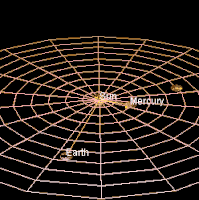Planets/Mercury
Mercury is the smallest and innermost planet in the Solar System.
Location
[edit | edit source]Sun | Mercury | Venus | Earth | Mars | Jupiter | Saturn | Uranus | Neptune
History
[edit | edit source]It is named after the Roman deity Mercury, the messenger of the gods.
Two spacecraft have visited Mercury: Mariner 10 flew by in 1974 and 1975; and MESSENGER, launched in 2004, orbited Mercury over 4,000 times in four years before exhausting its fuel and crashing into the planet's surface on April 30, 2015.[1][2][3] The BepiColombo spacecraft is planned to arrive at Mercury in 2025.
Features
[edit | edit source]Orbit
[edit | edit source]Its orbital period around the Sun of 87.97 days is the shortest of all the planets in the Solar System.
The first image in the gallery, below, is a computer program result for the orbit of Mercury. View is from above the ecliptic (North Pole). Mercury is in yellow. A circular orbit with the same semi-major axis is in grey for reference. The orbit is plotted in brighter colours above the ecliptic and darker below. Major axis is drawn showing perihelion (q) and aphelion (Q). Positions show every 5 days before and after the perihelion on May 20, 2006. For illustration the size of the sphere is inversely proportional to the distance from the Sun. The Sun is in the center. Yellow segment points toward the vernal point. Data for the plot is from the Jet Propulsion Laboratory.[4]
The second image is an animation of the revolutions of Mercury, Venus and Earth around the Sun. Mercury takes 88 days to complete an orbit, thus the animation shows it revolving around the Sun approximately 4.14 times (yellow trail) compared to Earth's 365 days (blue trail).
-
Orbit of Mercury is in Polar view, generated by a computer program. Credit: Eurocommuter.
-
Animation of Mercury's and Earth's revolution around the Sun. Credit: Lookang, Todd K. Timberlake and Francisco Esquembre.
Craters
[edit | edit source]Mercury's surface is heavily cratered and similar in appearance to Earth's Moon. Craters on Mercury range in diameter from small bowl-shaped cavities to multi-ringed impact basins hundreds of kilometers across. They appear in all states of degradation, from relatively fresh rayed craters to highly degraded crater remnants. Mercurian craters differ subtly from lunar craters in that the area blanketed by their ejecta is much smaller, a consequence of Mercury's stronger surface gravity.[5]
The largest known crater is Caloris Basin, with a diameter of 1,550 km.[6] The impact that created the Caloris Basin was so powerful that it caused lava eruptions and left a concentric ring over 2 km tall surrounding the impact crater. At the antipode of the Caloris Basin is a large region of unusual, hilly terrain known as the "Weird Terrain".
An unusual crater with radiating troughs has been discovered which scientists called "the spider."[7]
References
[edit | edit source]- ↑ "NASA Completes MESSENGER Mission with Expected Impact on Mercury's Surface". Archived from the original on May 3, 2015. Retrieved April 30, 2015.
- ↑ "From Mercury orbit, MESSENGER watches a lunar eclipse". Planetary Society. October 10, 2014. Retrieved January 23, 2015.
- ↑ "Innovative use of pressurant extends MESSENGER's Mercury mission". Astronomy.com. December 29, 2014. Retrieved January 22, 2015.
- ↑ Donald K. Yeomans (11 May 2011). Keplerian Elements for Approximate Positions of the Major Planets. Pasadena, California USA: Jet Propulsion Laboratory. http://ssd.jpl.nasa.gov/?planet_pos. Retrieved 2015-02-03.
- ↑ Spudis, P. D. (2001). "The Geological History of Mercury". Workshop on Mercury: Space Environment, Surface, and Interior, Chicago: 100.
- ↑ David Shiga (January 30, 2008). Bizarre spider scar found on Mercury's surface. NewScientist.com news service. http://space.newscientist.com/article/dn13257-bizarre-spider-scar-found-on-mercurys-surface.html.
- ↑ Staff (February 28, 2008). Scientists see Mercury in a new light. Science Daily. http://www.sciencedaily.com/releases/2008/02/080201093149.htm. Retrieved 2008-04-07.


